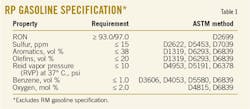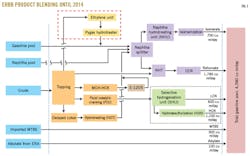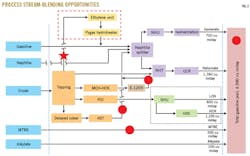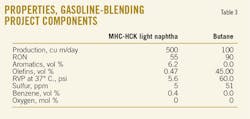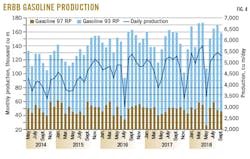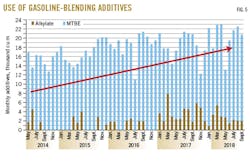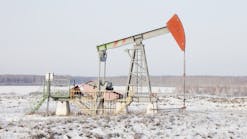Patricia Cabalá,
Enap Refinería Bío Bío
Hualpén, Concepción, Chile
State-owned Empresa Nacional del Petróleo (Enap) subsidiary Enap Refinerías SA has implemented a no-cost project to increase gasoline production at Enap Refinerías Bío Bío’s (ERBB) 118,000-b/d refinery at Hualpén, in Chile’s Bío Bío region.
The project—which required no capital investment and involved only coordinated efforts between different teams to identify previously unexplored opportunities at the complex—resulted in a 24% increase in gasoline production between 2014-18 using existing methyl tertiary butyl ether (MTBE) and intermediate streams. The project’s success relied on increasing availability of units producing blending components at the site, as well as increasing use of blending additives such as MTBE, alkylate, and butane.
Chile’s gasoline market
Enap owns, and through its subsidiaries operates three oil refineries in Chile, which alongside Bío Bío, include the 104,000-b/d Enap Refinerías Aconcagua (ERA) refinery at Concón in the Valparaíso region and Enap Refining & Commercialization Magallanes’s 15,700-b/d Gregorio refinery in the country’s southern Magallanes y Antártica Chilena region.
Through these three refineries, Enap supplies 95-99% of gasoline to Chile’s domestic market, which includes two main gasoline specifications: RM (for Santiago de Chile) and RP (for the rest of the country).
This article deals exclusively with the RP specification for distribution to markets outside of Santiago de Chile.
Table 1 shows the main properties of the RP gasoline specification.
Product blending until 2014
Up to 2014, ERBB’s production of RP gasolines with research octane numbers (RON) 93 and RON 97 averaged 4,580 cu m/day. The main components of the refinery’s gasoline-blending production included isomerate, reformate, light cracking naphtha (LCN), heavy cracking naphtha (HCN), MTBE, and alkylate.
The production process for these blending components at the refinery involved the following scheme:
• The naphtha splitter received gasoline feeds from the ethylene plant, naphtha and gasolines from storage tanks, stabilized naphtha from the mild hydrocracker (MHC) and high-pressure hydrocracker (HCK), and hydrotreated naphtha from the delayed coker.
• The top of the splitter connected to a naphtha hydrotreater and then to an isomerization unit, with an isomerate draw of 700 cu m/day.
• Output from the bottom section of the splitter blended with gasolines from the main topping units before entering a naphtha hydrotreater (NHT), which then fed a catalytic cracking reformer (CCR), where reformate was produced at 1,780 cu m/day.
• From a cracked gasoline hydrotreater (Prime G+), draws of HCN and LCN were produced at 600 cu m/day and 1,100 cu m/day, respectively.
• MTBE was imported to adjust the gasoline blending, while alkylate was delivered to ERBB from ERA’s refinery in Aconcagua.
Fig. 1 shows the scheme of ERBB’s gasoline-blending process up to 2014.
Table 2 details the flows and characteristics of the gasoline-blending components.
All base streams of ERBB’s gasoline-blending components were—and continue to be—prepared to comply with regulatory targets for the RP gasoline specification (Table 1).
Based on revised economic targets for the refinery, in 2014, ERBB decided to close the plant’s ethylene unit, freeing up all the topping gasoline that previously served as feedstock for the unit either to be exported to international markets (albeit at very unattractive prices) or to be made available for processing by other units at the complex.
Up until this time, the refinery did not feature an alternate means of handling its production of topping gasoline since that production fed entirely to the ethylene unit. With the elimination of the ethylene unit and the resulting new stream, the ERBB team came together to find a new destination within the refinery for this gasoline. Given rising demand in the domestic gasoline market, the refinery team proposed alternatives to increase gasoline production using existing units.
Increasing gasoline production
After defining its goal as creating a no-cost project to increase the refinery’s production of finished RP gasoline, ERBB tackled the challenge by building a team that included personnel from operations, maintenance, engineering, and corporate management offices such as optimization and supply. As part of the effort, the team thoroughly revised the refinery’s existing blending and production processes, identifying all useful streams used to produce gasoline in the refinery’s then-current configuration (Fig. 2).
The ERBB team next performed analytical evaluations on each of the different stream flows, identifying two main streams considered to be most valuable for the final blending scheme: the light naphtha stream (from the MHC and HCK) and the butane stream. The feed rate for the butane stream, however, was very limited due to sulfur specification.
Table 3 shows characteristics of the light naphtha and butane streams.
Following a complete review and analysis, the team determined all light naphtha coming from the HCK and MHC—despite its lower octane number—had high potential for use as part of a new blending scheme because of the refinery’s ability to use MTBE during blending to achieve desired octane targets.
To introduce the MHC-HCK light naphtha streams to the blending process, required only minor adjustments to refinery piping, allowing the team to quickly handle the remaining details of the reconfiguration effort to achieve the proposed blending goal.
With simply the small piping changes, the team was equipped to implement a large blending achievement, as up to 80% of the topping gasolines could now feed the naphtha splitter because of the increased capacity available following the ethylene plant’s decommissioning.
Fig. 3 shows the revised scheme of ERBB’s gasoline-blending process following the 2015 project.
Other small improvements also were implemented during the blending reconfiguration project, including minor projects designed to increase production of isomerate, LCN, and HCN.
Results
Because of the collective, no-cost projects based on interdisciplinary team work to analyze alternatives aimed at optimizing the refinery’s production of gasoline during the blending process, ERBB has been able to increase final RP gasoline production to 5,760 cu m/day.
In 2014, ERBB’s monthly gasoline production stood at about 130,000 cu m, which by August 2018 rose to 172,000 cu m, a 24% increase (Fig. 4).
Monthly use of MTBE in the blending process also rose to 18,000 cu m in 2018 from 8,000 cu m in 2014, a 125% increase (Fig. 5). This increase reflects the use of light naphtha in the new blending formula.
Given the improvements achieved as a result of the blending project, the ERBB team continues to search for and identify other hidden opportunities to increase production in different areas of the refinery that similarly will not risk major capital expenditures.
The author
Patricia Cabalá ([email protected]) is operations department manager at Enap Refinería Bío Bío, where she oversees production of all the refinery’s 20+ process units, tank farms, and oil terminal. With more than 10 years’ experience in refinery processes, she has held various positions within the organization as a process engineer and division manager, working in production planning, crude purchases, gasoline blending, and production programs. She holds a BS (2005) in chemical engineering and MS (2005) in environmental engineering from Universidad de Concepción Chile, as well as an MS (2015) in business management for the energy industry from Pontificia Universidad Católica de Chile.
